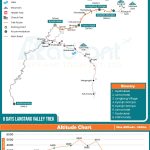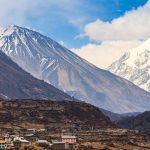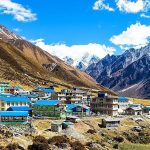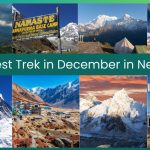Overview
There is something about the Himalayas that just pulls you in, doesn’t it? One day, you are scrolling through photos of those snow-draped peaks and quiet trails. And before you know it, you are picturing yourself there. The good news is that you have plenty of such options to explore in Nepal if you decide actually to be in the Himalayas. The Langtang Valley trek and the Annapurna Base Camp (ABC) trek are some of them.
Both treks share common features, but they are distinct in their own right. These treks are incredible because they feature raw Himalayan beauty, warm smiles from local villagers and views that make you stop in your tracks. But they have very different personalities.
Langtang feels like a secret that not everyone’s discovered yet. It’s closer to Kathmandu, less crowded and rich in culture. You walk through Tamang villages, past Buddhist monasteries and along the valleys that are still showing quiet signs of strength after the 2015 earthquake.
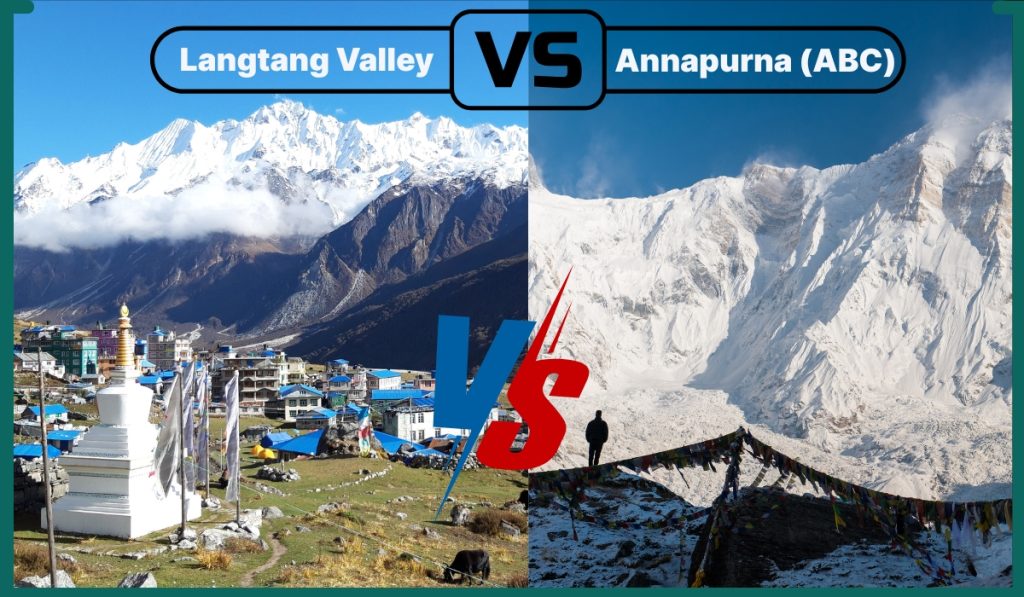
Annapurna Base Camp, on the other hand, is a classic journey. It attracts trekkers from around the world and is a popular trek route. The trails take you through lush forests and terraced fields before opening up to the icy amphitheater of the Annapurna massif. Standing at Base Camp is a feeling that’s hard to describe. It is both humbling and exhilarating.
If you are doing a Langtang Valley vs Annapurna Base Camp trek comparison, then you should know that the choice depends on what kind of adventure you want. Langtang is ideal if you are after a shorter, quieter and more cultural trek. ABC is for those who want a bit more variety and that triumphant “I made it!” moment at the end.
Highlights
- Langtang is a quick getaway from Kathmandu and is perfect if you are short on time
- Annapurna Base Camp features diverse landscapes and stunning views
- Langtang offers solitude with fewer people on the trail and a deeper connection with the Tamang culture
- ABC trek means steeper climbs, longer days on the trail
- Langtang welcomes beginners, as trekking can be done in less challenging terrain
- Spring and autumn are magic windows for both treks as they have clear skies, blooming rhododendrons and crisp air
Route Overview: Langtang Valley and Annapurna Base Camp Treks
Nepal’s Himalayan treks offer a mix of natural beauty and rich cultural encounters. It is true for the Langtang Valley trek and the Annapurna Base Camp trek, too. Similarly, both routes start relatively close to major hubs. And they cater to moderately fit hikers who want that mix of challenge and reward. Here is a brief overview of both treks.
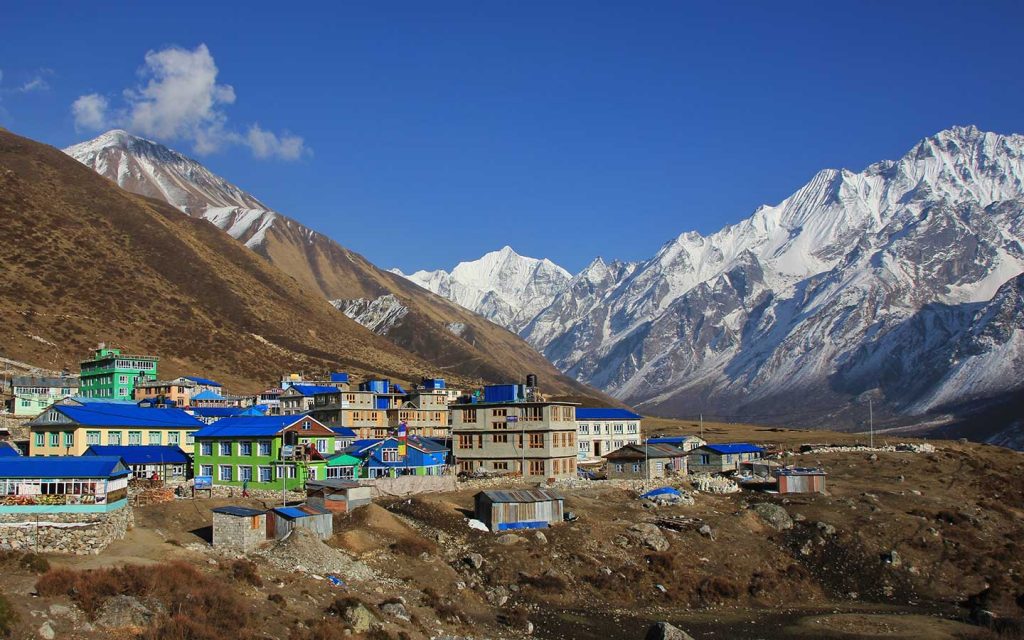
Langtang Valley Trek
Picture this: You are bouncing along a dusty road from Kathmandu, and within hours, you are at the trailhead in Syabrubesi. That’s the beauty of Langtang. It is the closest major Himalayan trek to Nepal’s capital. Thus, this trek is perfect for those short on time but big on wanderlust.
The Langtang Valley, part of Langtang National Park, stretches north toward the Tibetan border. And it offers a mix of dense forests, rushing rivers and stark glacial landscapes. It’s not as famous as the Everest Base Camp trek or the Annapurna. Thus, there are fewer crowds, and it provides a more authentic feel.
A standard Langtang trek itinerary offered by Radiant Treks is either 8 days or 10 days long. The journey covers about 70 kilometers round-trip.
You start at Syabrubesi (around 1,500m), winding up through bamboo groves and pine woods to places like Lama Hotel (2,470m) on day two of the trek. By day three, you are in Langtang Village (3,430m), a spot that’s risen from the ashes of the 2015 quake. The locals have rebuilt this place with grit. You will hear those stories over butter tea in the village.
The highlight? Kyanjin Gompa at 3,870 meters, where you can hike side trips to viewpoints like Tsergko Ri (5,000m) for panoramas of Langtang Lirung (7,227m) and other peaks. Descent mirrors the ascent of the Langtang Valley trek. But there are other options, too. You can loop via Gosaikunda Lake if you want to extend your journey.
Overall, it’s a trek that rewards those seeking solace amid nature’s rebuild.
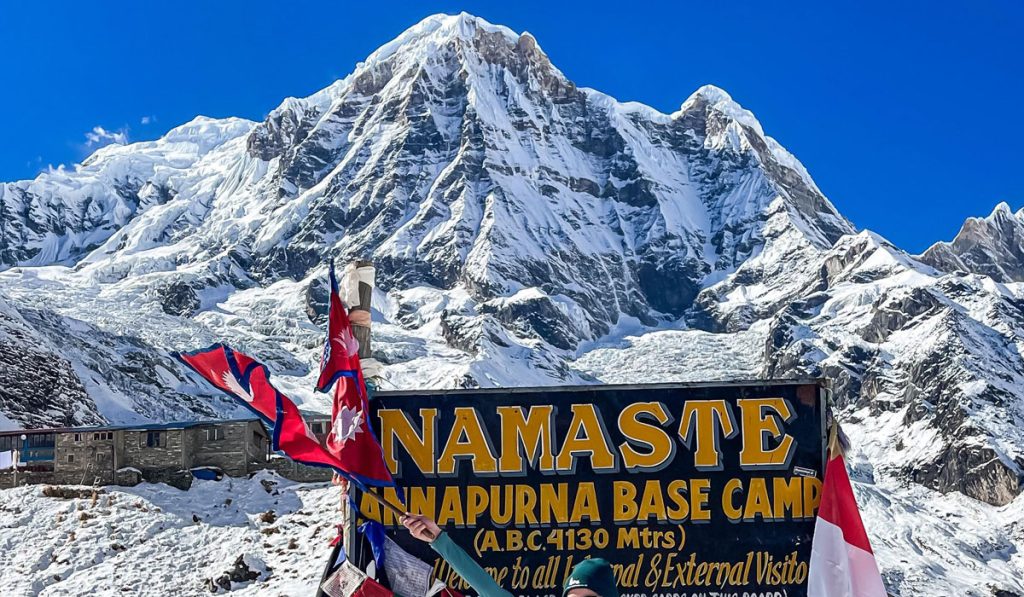
Annapurna Base Camp Trek
Shift gears to the Annapurna region, and you are in for a trek that is like a highlight reel of Nepal’s diversity. Starting from the lakeside chill of Pokhara, the ABC trek catapults you into the heart of the Annapurna Sanctuary, a natural amphitheater surrounded by giants like Annapurna I (8,091m) and Machapuchhre (6,993m). The latter is the fishtail peak, sacred and unclimbed. It’s more developed than Langtang, with better facilities, but that comes with busier trails.
The itineraries for the Annapurna Base Camp trek by Radiant Treks are of 6 days, 10 days, or 13 days. This trek covers around 110 kilometers. The journey includes a flight or drive to Pokhara first and then a jeep to Nayapul.
Day one eases you in through terraced fields to Tikhedhunga (1,570m). Climb stone steps to Ghorepani (2,860m) for a sunrise at Poon Hill (3,210m) — views of Dhaulagiri and Annapurna South are legendary. Push through rhododendron forests (blooming pink in spring) to Tadapani, then Sinuwa and Deurali, before the final ascent to ABC at 4,130 meters. There, you are surrounded by a 360-degree wall of snow — it’s humbling. Return via hot springs at Jhinu Danda for a soak.
Culturally, ABC is a melting pot: Gurung and Magar villages dot the path, with teahouses serving dal bhat fueled by local hospitality. Likewise, festivals like Dashain add color if you are there for an autumn trek. Scenery shifts dramatically — from subtropical banana groves to barren moraines — making each day feel fresh.
Guides and porters are common, especially for carrying gear. The infrastructure shines: Wi-Fi in lower villages, varied menus and even hot showers. ABC suits those craving variety and that Base Camp badge of honor.
Outline Itinerary

Annapurna Base Camp with Poon Hill Trek Itinerary
- Day 1: Arrival in Kathmandu (1,400 m / 4,593 ft)
- Day 2: Drive from Kathmandu to Pokhara (822 m / 2,697 ft), Distance: 200 km / 124 miles, Duration: 6 to 7 hours by tourist bus
- Day 3: Drive from Pokhara to Nayapul (1,070 m / 3,510 ft), Trek to Tikhedhunga (1,540 m / 5,052ft), Distance: 9 km / 5.6 miles, Duration: 3 to 4 hours
- Day 4: Trek from Tikhedhunga to Ghorepani (2,850 m / 9,350 ft), Distance: 12 km / 7.5 miles, Duration: 5 to 6 hours
- Day 5: Hike to Poon Hill (3,210 m / 10,531 ft) for sunrise, Return to Ghorepani, Trek to Tadapani (2,630m / 8,628 ft), Distance: 10 km / 6.2 miles, Duration: 5 to 6 hours
- Day 6: Trek from Tadapani to Upper Sinuwa (2,340 m / 7,677 ft), Distance: 14 km / 8.7 miles, Duration: 6 to 7 hours
- Day 7: Trek from Sinuwa to Deurali (3,200 m / 10,498 ft), Distance: 10 km / 6.2 miles, Duration: 6 to 7 hours
- Day 8: Trek from Deurali to Annapurna Base Camp (4,130 m / 13,549 ft), Distance: 9 km / 5.6 miles, Duration: 5 to 6 hours
- Day 9: Sunrise at ABC, Trek back to Bamboo (1,760m / 5,774ft), Distance: 14 km / 8.7 miles, Duration: 6 to 7 hours
- Day 10: Trek from Bamboo to Chhomrong (1,951m / 6,400ft), Distance: 9 km / 5.6 miles, Duration: 6 to 7 hours
- Day 11: Trek to Jhinu Danda (1,700 m / 5,577 ft), visit hot springs, Drive to Pokhara, Distance: 5 km / 3.1 miles, Duration: 2 hours trek, 3 hours drive
- Day 12: Drive from Pokhara to Kathmandu, Distance: 200 km / 124 miles, Duration: 6 to 7 hours
- Day 13: Departure from Kathmandu
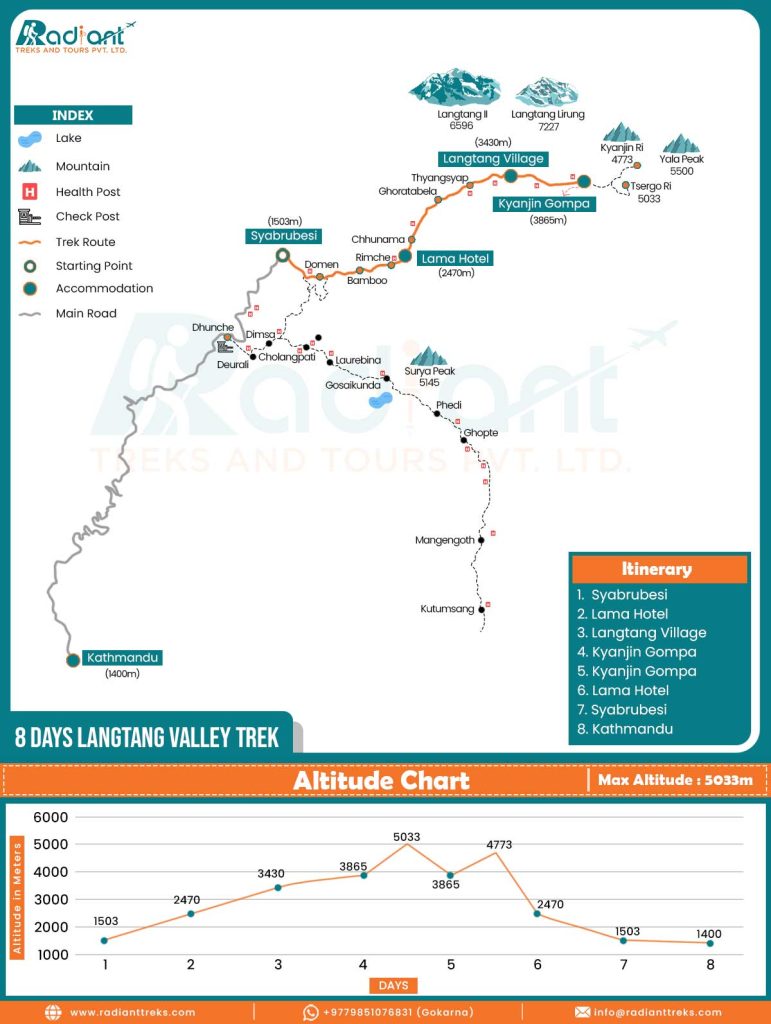
8 Days Langtang Valley Trek Itinerary
- Day 1: Drive from Kathmandu to Syabrubesi (1,503 m / 4,931 ft), Distance 120 km, Duration 6 to 7 hours
- Day 2: Trek from Syabrubesi to Lama Hotel (2,470 m / 8,103 ft), Distance 11 km, Duration 5 to 6 hours
- Day 3: Trek from Lama Hotel to Langtang Village (3,430 m / 11,253 ft), Distance 10 km, Duration 6 to 7 hours
- Day 4: Trek from Langtang Village to Kyanjin Gompa (3,865 m / 12,680 ft), Distance 9.7 km, Duration: 5 to 6 hours
- Day 5: Hike to Tsergo Ri (5,033 m / 16,512 ft) and return to Kyanjin Gompa (3,865 m / 12,680 ft), Distance: 9 km, Duration: 5 to 6 hours
- Day 6: Hike to Kyanjin Ri (4,773 m / 15,659 ft) and trek to Lama Hotel (2,470 m / 8,103 ft), Distance: 21 km, Duration: 6 to 7 hours
- Day 7: Trek from Lama Hotel to Syabrubesi (1,503 m / 4,931 ft), Distance: 11 km, Duration: 5 to 6 hours
- Day 8: Drive from Syabrubesi to Kathmandu, Distance: 20 km, Duration: 6 to 7 hours
Difficulty and Physical Requirements
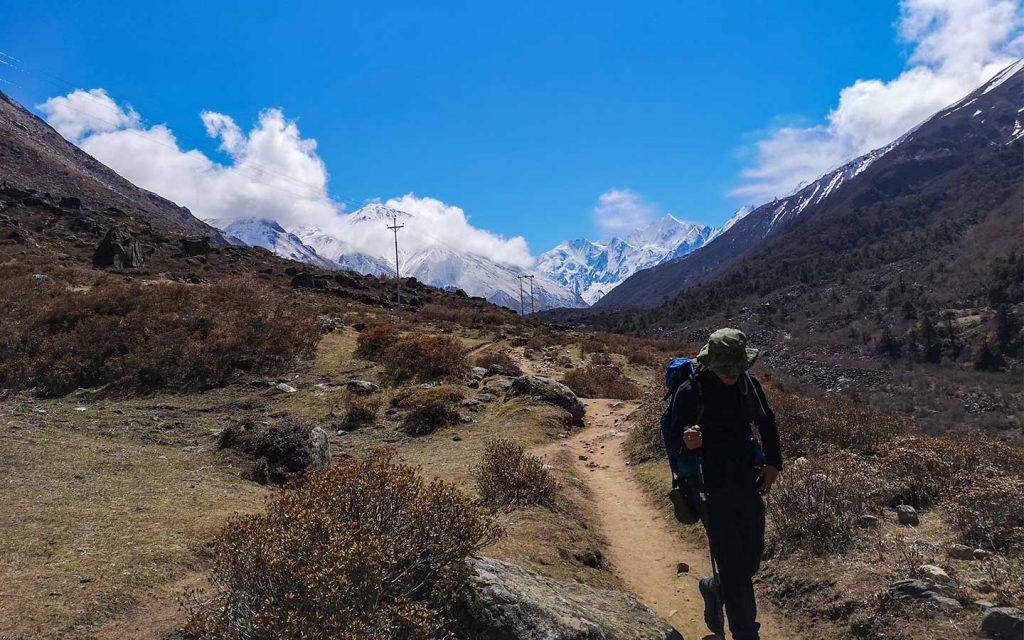
Let’s be real — neither trek is a stroll, but they hit the body differently. Langtang earns its moderate difficulty label with steady and forgiving trails. In this trek, you are looking at 2,500 meters of total elevation gain, topping out at 3,870 meters in Kyanjin Gompa. However, the hike to Tsergo Ri (5,033m) is an additional challenge.
Daily hikes of 5 to 7 hours feel rhythmic rather than brutal. The lower maximum altitude means fit beginners can handle it with a couple of months of weekend hill walks and stair sessions. Acute Mountain Sickness is a risk above 3,000 meters. But the gradual climb gives your body time to adjust.
However, Annapurna Base Camp is a moderate-to-strenuous trek. You will cover roughly 3,000 meters of elevation gain, with the infamous 3,000-plus stone steps from Ulleri to Ghorepani as the wake-up call.
Daily walking stretches to 6 to 7 hours, and the weather swings wildly. The final push to 4,130 meters at the Annapurna Base Camp tests your lungs and legs alike. Altitude hits harder here. Extra rest days for acclimatization can be a wise choice.
For this particular trek, you need to prepare with cardio exercises. They include long training hikes with a loaded pack, and maybe a few rounds of squats for those endless stairs.
Also, one needs to pack medicine like Diamox. And make sure to hydrate like it’s your job, and listen to your body.
To conclude, Langtang forgives small mistakes. It means even if you miss a training day or skip a rest stop, the steady valley rhythm usually lets you recover without drama.
However, ABC demands respect from the trekkers. Underestimate the stairs or altitude and it will humble you fast.
Scenery and Landscapes
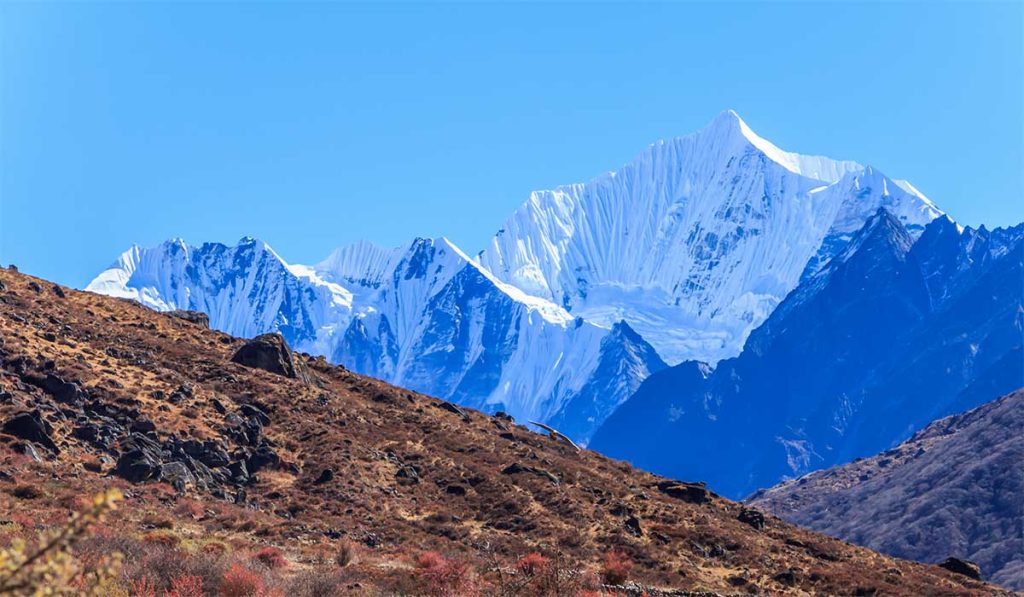
The Langtang Valley trek can be called a quiet love letter to the mountains. That is so because when on this trek, you feel like being tucked inside a green-walled valley. You can see pine and rhododendron trees brushing your shoulders. Similarly, you will witness the Langshisa Glacier shining just ahead like a secret. Dorje Lakpa and Langtang Lirung loom close enough to feel personal. Add to that the wildflowers that carpet the ground in spring. Furthermore, the whole scene of this region stays intimate and almost meditative. One landscape, perfectly framed.
Similarly, the Annapurna Base Camp trek is the blockbuster for views. Day one, you are sweating through banana groves and rice paddies. And on the fourth day of the trek, you are in exploding pink rhododendron tunnels. Then, suddenly, it gives way to stark alpine rock and the sanctuary slams into view — an amphitheater of 7,000-meter giants circling you in 360 degrees.
Meanwhile, Poon Hill sunrise paints Dhaulagiri gold, and Machapuchhre seems like piercing the sky. You realize that every turn on the trek offers something.
Wildlife and Nature

Langtang National Park is rich in animal diversity. You can see red pandas rustling in bamboo, Himalayan tahr grazing ridges and over 300 bird species flit through pines. Post-2015 quake, trail restoration and community forestry have kept erosion in check. On the other hand, ABC’s conservation area has sheltered snow leopards and musk deer.
Nonetheless, both routes require you to follow the rules of leave-no-trace. Thus, you need to pack out trash, use the teahouse toilets and avoid single-use plastics.
Cultural Experiences
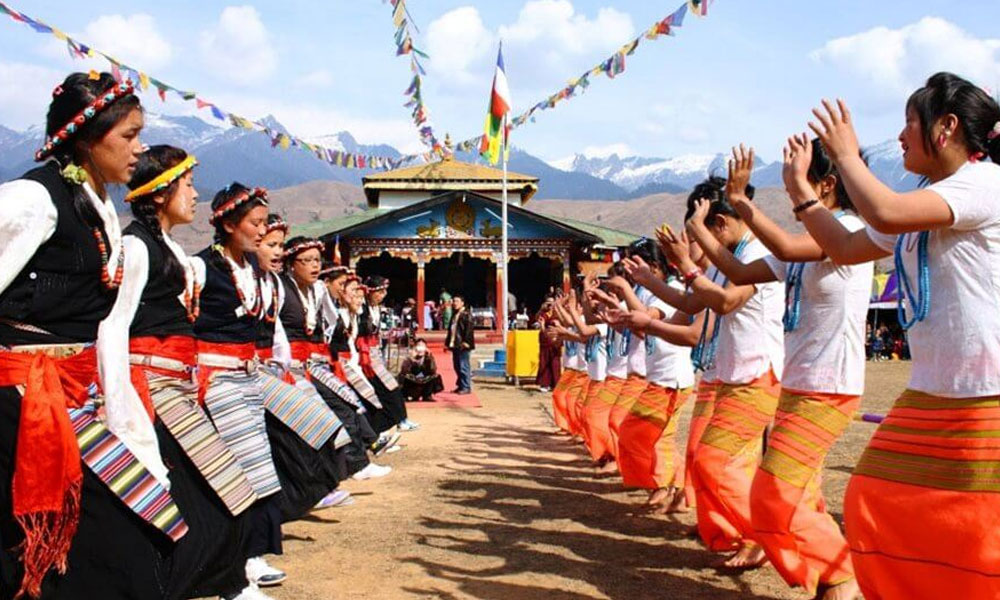
Every trek in Nepal is about people and their culture, as well as mountains. So, one thing is sure in the Langtang Valley Vs Annapurna Base Camp trek comparison — both these journeys let you step into local lives.
Langtang pulls you into the Tamang world like a warm hearth. Prayer flags, butter lamps in Kyanjin Gompa and salty tea at teahouses are some of those elements. A chance to spin prayer wheels, taste yak cheese fresh from the factory, and sleep in family-run teahouses are other factors that give a glimpse of local lives.
This trek to Langtang Valley is raw, unfiltered and deeply personal. It means tourism feels secondary to daily life.
Similarly, trek to the Annapurna Base Camp brings you face-to-face with people from Gurung, Magar and mixed communities. Stone alleys along the trekking trail echo with porters’ laughter. Chhomrong markets sell handmade shawls. You can also witness Dashain festivities if you are there in October and November.
But the trail’s popularity means interactions can feel rushed and you may not get a chance for a deep connection with the locals.
Accommodation, Food and Other Facilities

The Langtang Valley and Annapurna Base Camp treks operate on the traditional teahouse system of Nepal. Locally run teahouses provide both meals and lodging facilities to the trekkers.
In Langtang, the accommodation is basic. You can expect basic wooden rooms with thin mattresses, shared toilets and hot water that usually comes by the bucket and is heated by solar power. Electricity can be patchy and Wi-Fi is only available in a few places.
Likewise, the menus are straightforward — think dal bhat, momos and noodle soup. Despite the simplicity, the food refuels you after a long day on the trail. Likewise, the teahouses tend to have a communal feel. That is to say, trekkers, guides and porters often gather in the dining hall to chat, play cards, or share stories over cups of tea.
On the contrary, the Annapurna Base Camp trek offers a wider range of facilities. In lower villages such as Chomrong and Sinuwa, you’ll find teahouses with private bathrooms, consistent electricity and even bakeries serving apple pie or cinnamon rolls. The menus are more varied and offer traditional Nepali meals along with pasta, fried rice and pizza or beer. Hot showers are common up to around 3,000 metres. And most teahouses provide charging points for electronic devices.
Accessibility, Permits, Insurance

Getting to the trailhead, sorting transport and securing permits can make or break your trek. Here is how the Langtang Valley Vs Annapurna Base Camp trek comparison looks in the real world.
Accessibility
Langtang is the clear frontrunner for convenience. A straightforward 7 to 8-hour jeep or bus ride from Kathmandu lands you at Syabrubesi and you are ready to walk the next morning. There is no need for flights or transfers.
But the Annapurna Base Camp trek demands an extra step. That means first you need to reach Pokhara, either by a 6 to 7-hour tourist bus or a quick flight of 30 minutes from Kathmandu. After that, you need to travel via a jeep to Nayapul. That adds a full travel day and more moving parts before the boots hit dirt.
Solo travelers can handle both, but ABC’s extra legs mean tighter schedules and a higher risk of weather or transport hiccups.
A guide is not mandatory in both treks, yet they streamline bookings and buffer delays, especially on the busier Annapurna route.
Permits
Paperwork is minimal for both treks. And it is even more so if you opt to trek with Radiant Treks. The Langtang Valley trek needs just the Langtang National Park entry permit. ABC requires the Annapurna Conservation Area Permit (ACAP). Nonetheless, in both treks, checkpoints scan your permit.
Travel Insurance
Don’t leave for either of the treks without travel insurance. That is because high-altitude trekking demands good coverage. Both routes top 4,000 meters, so look for policies that include helicopter evacuation up to 5,500 meters, medical treatment for Acute Mountain Sickness and trip cancellation due to weather or injury.
Best Time for Langtang Valley and ABC treks
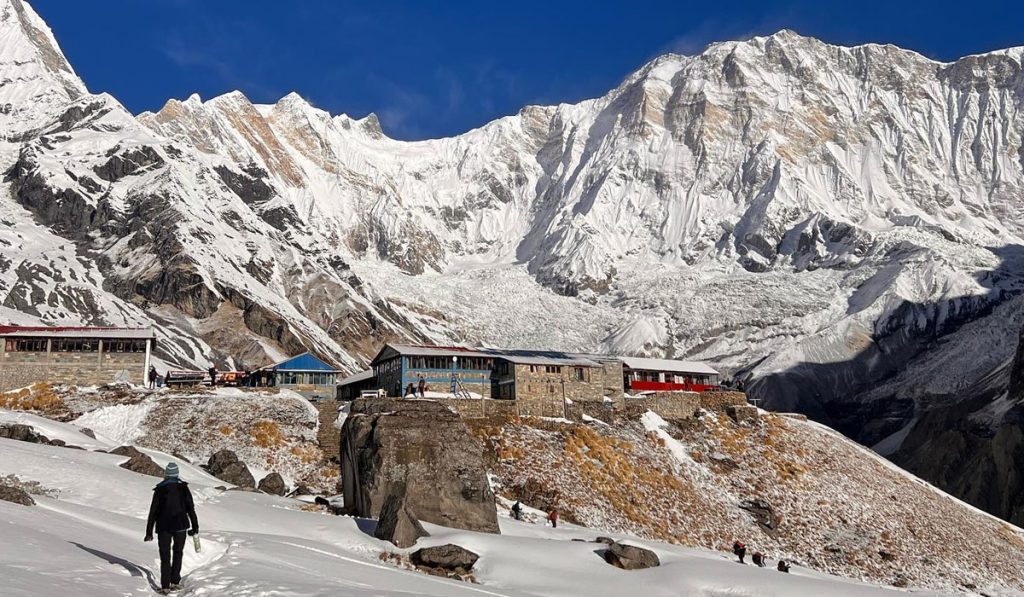
Timing is everything in the Himalayas — get it right and the mountains reward you. But get the timing wrong and you are soaked or snowed in. So, choose the right time if you are heading either for the Annapurna Base Camp trek or the Langtang Valley trek.
Spring (March–May) and autumn (September–November) are the gold standards for both treks. Days hover 5°C to 20 °C and nights dip below freezing at altitude in spring. Likewise, skies stay crisp and clear for postcard views. Rhododendrons blaze pink in Annapurna Base Camp’s lower forests. Meanwhile, Langtang’s valleys glow with wildflowers. Trails are busy at this time of the year, yet they are manageable.
Similarly, autumn brings the clearest air. The post-monsoon skies make Annapurna’s giants razor-sharp, though ABC sees peak crowds. Thus, you need to book teahouses early. However, Langtang stays quieter compared to ABC, even in October.
Winter (December–February) is Langtang’s secret season. That is because it is cold (-10 °C nights) but doable with down gear and microspikes. Teahouses also stay open and crowds almost vanish. On the contrary, ABC shuts down above Ghorepani as heavy snow blocks the sanctuary.
Meanwhile, monsoon (June–August) turns both treks into slip-and-slide adventures. Langtang’s leeches and mud are annoying but passable. And ABC’s exposed ridges risk landslides, which is why most avoid trekking in these months.
If solitude trumps comfort, shoulder seasons work. But make sure to pack rain gear and remain flexible in your itinerary. Check forecasts because a single storm can close roads for days.
Which Trek Should I Choose?

The Langtang Valley trek is for those short on time. Also, if you are seeking quieter trails with cultural immersion, this trek is for you. Its easy access from Kathmandu and fewer crowds make it ideal for beginners or solo travelers.
This trek is affordable, approachable and offers genuine interactions. Yet be ready for less landscape variety. You also have to be mentally prepared to deal with basic facilities along the trail.
The Annapurna Base Camp trek is fit for those who want diverse scenery. This includes the journey from jungles to alpine sanctuaries. Add to that the triumphant base camp arrival. The itinerary of this trek offers comfort, vibrant villages and daily surprises.
If you are an adventurer in search of epic views and better infrastructure, the Annapurna Base Camp trek is for you. But if you hate crowds, then the peak season is not for you to trek here.
Likewise, consider your fitness (ABC tests endurance more), group dynamics (Langtang for intimacy) and season (both peak in spring/autumn). Langtang is the best for newbies or culture lovers. ABC is for scenery addicts. Nonetheless, train consistently, consider a guide for safety and check the weather before setting out for both treks.
Either way, you will come back transformed. So, pick what aligns with your adventure vibe.
FAQS
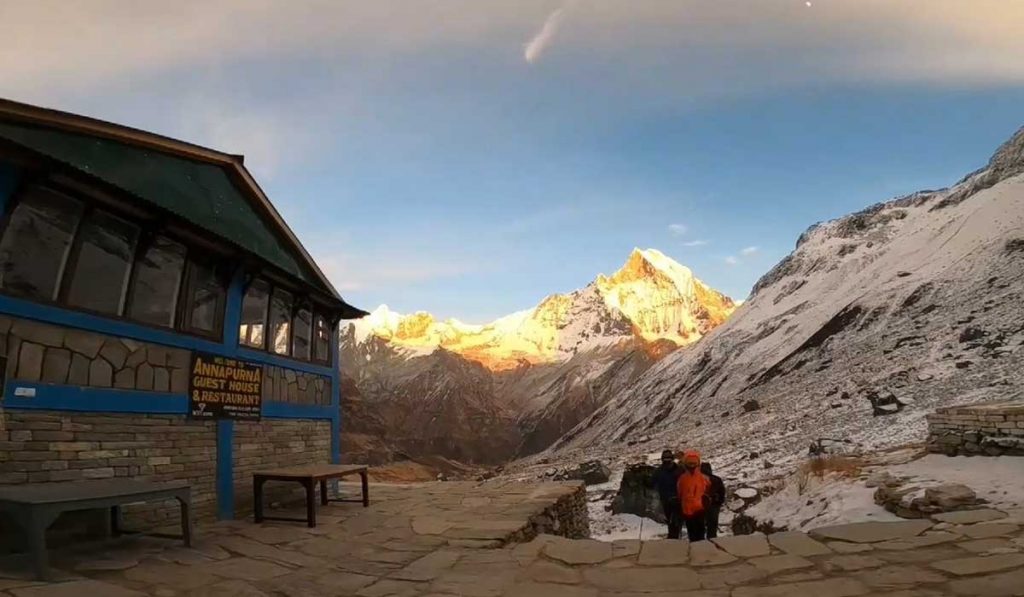
Which stands out — in Langtang Valley and Annapurna Base Camp treks comparison — for time-constrained trekkers?
The Langtang Valley trek is best as it is shorter. Also, the trailhead Syabrubesi is easily accessible from Kathmandu. You do not need flights to reach there. But the Annapurna Base Camp trek stretches to 13 days, with the need to travel to Pokhara before reaching the trailhead.
I’m a beginner. Which one should I pick?
You should choose the Langtang Valley trek as it features steady climbs and a forgiving pace. These factors make it less intimidating than the challenging staircases in the ABC trek and 4,130 m finish.
Where will I see more dramatic scenery?
It is during the Annapurna Base Camp trek. You can see jungles, rhododendrons, Poon Hill sunrise and then the full Annapurna amphitheater.
Which has fewer crowds?
Langtang. Even in peak season, you’ll share the trail with fewer trekkers. But ABC gets packed, especially in October and April.
What about teahouse comfort?
ABC wins as it boasts attached bathrooms, Wi-Fi and apple pie in lower villages. Langtang is rustic and it has shared squat toilets, basic menus and a pure mountain vibe.
Do I need a guide or porter?
It is not mandatory, but recommended for both. Langtang is simpler to solo; ABC’s busier trail and logistics reward local knowledge.




